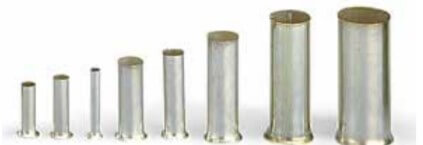Ferrule Types: An Overview of Applications and Uses

There are various types of ferrules available in the electrical market. Ferrules can be used in different applications. Almost all electricians are familiar with them. However, they all know that there is a wide variety of ferrules that are very different from each other and provide many different purposes. Before describing the types, I want to make the definition of a wire ferrule.
Wire ferrule is a type of pin terminal used to prevent the unraveling of stranded wire and to increase the stability of electrical connections. It ensures reliable electrical connections and prevents conductor breakage due to bending, wire stress, or vibration while facilitating wire insertion into the terminal clamp.

To connect a ferrule, first, you should strip it. Then you should crimp it to the cable end with a special crimping tool.
The construction of a ferrule is simple. The metal part is made of copper and is covered with tin. The sleeve is made of polyamide or PVC.
You should also be careful with its diameters. It is usually matched to the cross-section of the cable to which it will be connected. For example, a 2.5 Ferrule means that it will be connected to a 2.5mm2 cable.
Types of Ferrules
There are four different types of ferrules: Insulated, non-Insulated, single, and twin.
1. Insulated ferrule
The insulated wire ferrule has a plastic-colored sleeve over the tin-plated copper tube. It allows visual color designation of wire size to aid in identification and quality inspection. Insulated wire ferrules are easier to work with, especially on smaller conductors. It can be used in any type of application and ensures a reliable connection.
2. Uninsulated ferrule
The uninsulated ferrule does not come with a plastic sleeve. It prevents wire strands from fraying and breaking and is extremely cost-effective. The shorter length and uninsulated body offer advantages when making terminations in printed circuit board terminal blocks and in other terminal blocks with smaller clamps or narrow widths.
3. Single ferrule
The single ferrule can be crimped into one cable. It can be either insulated or uninsulated. It consists of a cylindrical tube with a threaded end that can be screwed onto a wire. The opposite end of the ferrule has a crimping mechanism that allows it to be secured onto the wire, creating a solid electrical connection.
4. Twin ferrule
The twin ferrule can be crimped into two cables. It has larger diameters and special-shaped sleeves that accept two conductors of the same or different sizes. It provides an efficient connection of multiple wires in the same terminal clamp or simplifies the wire jumper between terminal clamps.
All types explained above should be crimped properly. Let me explain the crimping procedure:
- Strip the insulation from the end of the wire and insert it into the insulated end of the ferrule.
- Using the designated crimping tool, place the metal shaft into the tool’s appropriate slot. Compress the tool to make a crescent-shaped depression along the length of the ferrule.
- Insert the crimped ferrule into the terminal block.
- Tighten the ferrule and wire into the terminal block.

The parameters to be considered when choosing a ferrule are as follows.
- The cross-section of the cable.
- Color.
- Ferrule dimensions. (plastic and metal parts)
- Structure of the header. (Insulated or non-insulated)
- Cable stripping length.
- Single or double connection.
- International standards.
Most ferrules are produced in different color codes according to DIN, UL, and NFC standards.






 Best Electrical Tapes for Outdoor Use: Buying Guide
Best Electrical Tapes for Outdoor Use: Buying Guide  What is an Arc Flash Relay? How Does it Work?
What is an Arc Flash Relay? How Does it Work?  What is a Dual Function Circuit Interrupter? And Its Function
What is a Dual Function Circuit Interrupter? And Its Function  Advantages and Disadvantages of Incandescent Lamps
Advantages and Disadvantages of Incandescent Lamps  VFD Parts: A Guide to Their Essential Functions
VFD Parts: A Guide to Their Essential Functions  Applications of 3-Phase Induction Motors in Industries
Applications of 3-Phase Induction Motors in Industries